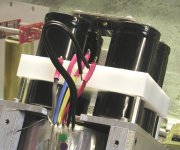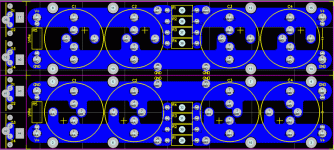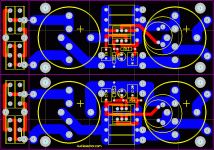Variac said:...better to space the output devices a bit more ?
That question was raised already before, with A30 boards. But in reality, it worked pretty well and nobody complained about heat distribution issues.
Such board is also more universal, and can be implemented in many different ways on variety of heatsink shapes ans sizes. If someone wishes to space them more, attaching wires jumpers could be a simple and practical solution. Besides, that wouldn't be much different than longer PCB traces (on larger boards).
If he doesn't I wouldn't worry. It is really quite easy to wire up a power supply. Just attach the big caps with the circular brackets made for the purpose, which make a stronger and more reliable installation than a circuit bd. IMHO. The diode bridges need to be attached to the case for cooling anyway...
Member
Joined 2002
Peter Daniel said:Here's a nice way to wire the PS caps:
Peter people want psu boards because they are A) begginners B) it looks nicer and goes together nicer C) simple to put to gether,,
Do you want me to get Briangt to do the boards ? I ve asked him to just make the original board he has smaller thats all that needs to be done, just needs 4psu caps and the other stuff such as the thermister and led for power.
J'
You are right Peter. The A 30 shows it will work fine, and having the same form factor will make some people with the A30 very happy indeed!
Variac said:and having the same form factor will make some people with the A30 very happy indeed!
Yes, that's the main idea here, just swap the boards and have brand new amp 😉 That's why I think PS boards are not that critical, most people already have some sort of PS.
Member
Joined 2002
Peter Daniel said:
Yes, that's the main idea here, just swap the boards and have brand new amp 😉 That's why I think PS boards are not that critical, most people already have some sort of PS.
No most people don't even have a F4, only some have the A30, lets stick to what people wanted and have been asking for, if you favor other things lets do that but my goal is to get what people are asking for..
J'
I find it funny that someone here will beg for boards and then if someone offers ones they do not like they b!tch and b!tch and b!tch. If you know what you want then why not do like the rest of them and DIY
I will put in my 2 cents. I will be in for 2 sets of boards either way, and I would not need a power supply board. I have gone to using lots of smaller caps instead of large caps. This doesn't tend to work too well with PS boards.
Again this is just my 2 cents.
Thanks Peter for taking this on.
DaveM
Again this is just my 2 cents.
Thanks Peter for taking this on.
DaveM
Alright, I will come up with a universal PS board, exactly same size as two amp boards.
That supply will be good for the F amps, as well for other purposes, as I plan to implement option for 3 pin regulators (in place of series resitors) , so many other applications will become also possible (preamps, CDP, DACs, even GC).
That supply will be good for the F amps, as well for other purposes, as I plan to implement option for 3 pin regulators (in place of series resitors) , so many other applications will become also possible (preamps, CDP, DACs, even GC).
While I'm at it, let me state how unbelievably cool it is to have an opportunity to benefit so profoundly from the efforts and generosity of Nelson Pass (I am not worthy) and Peter Daniels (who makes things that tweek my aesthetic sensibilities like no one else), and many others. There is no way I could ever afford to buy this stuff, but to be able to spend hours and hours reading about it, thinking about it, accumulating the parts, designing the 'housings, and slinging some solder, to end up ready to build something else is...fun. Really, really fun. Thanks again. Ok, I'll stop being so sappy now.
Thanks for a token of appreciation.
I'm glad I was pursuaded to work on that PS board as it came out prett nice. The size is 3.35 x 4.8".
Starting with diodes, the board will accept standard TO-220 packages as well 2 and 3 pin rectifiers (common cathode) in TO-247 package.
The rectifiers section is separated with a scoring line and it can be separated from main board with diodes attached to chassis or special plate for cooling (pin bending required). Cooling plates can also be attached to diodes mounted directly on a board, when heat dissipation is not that demanding.
The capacitors with diameter up to 35mm (40mm tightly) will fit. What's important though, I created a layout where advantages of 4 pole Jensen caps can be implemented to a full extend: http://www.jensencapacitors.com/audio/white-papers/4pole.html
I was really hesitant to come up with a boad to hold just 4 caps for power amplifier supply. To make it more worthwile, I also included space for regulators in addition to passive filtering. In case the board will be used for a preamp, DAC, CDP, or some other purpose where high current demads are not required, one can install 3 pin regulators in place of the series resistors: LM78XX, LM2937, adjustable LM317, LT1086 and their negative counterparts all will work here. There is also enough space for regulator's heatsinking.
Pretty nice, isn't it? That board may actually sell better than the amps 😉
I'm glad I was pursuaded to work on that PS board as it came out prett nice. The size is 3.35 x 4.8".
Starting with diodes, the board will accept standard TO-220 packages as well 2 and 3 pin rectifiers (common cathode) in TO-247 package.
The rectifiers section is separated with a scoring line and it can be separated from main board with diodes attached to chassis or special plate for cooling (pin bending required). Cooling plates can also be attached to diodes mounted directly on a board, when heat dissipation is not that demanding.
The capacitors with diameter up to 35mm (40mm tightly) will fit. What's important though, I created a layout where advantages of 4 pole Jensen caps can be implemented to a full extend: http://www.jensencapacitors.com/audio/white-papers/4pole.html
I was really hesitant to come up with a boad to hold just 4 caps for power amplifier supply. To make it more worthwile, I also included space for regulators in addition to passive filtering. In case the board will be used for a preamp, DAC, CDP, or some other purpose where high current demads are not required, one can install 3 pin regulators in place of the series resistors: LM78XX, LM2937, adjustable LM317, LT1086 and their negative counterparts all will work here. There is also enough space for regulator's heatsinking.
Pretty nice, isn't it? That board may actually sell better than the amps 😉
Attachments
Member
Joined 2002
Peter you need more ouput holes. Ie 2 per rail so we can use 2 amps per board, not one board per amp. 🙂
The output holes on the right are for Jensens only.
There are two more output holes beside resistors (for each rail) and four output holes for ground (per each half of the board).
If I do more holes the board will look like Swiss Cheese 😉
There are two more output holes beside resistors (for each rail) and four output holes for ground (per each half of the board).
If I do more holes the board will look like Swiss Cheese 😉
Member
Joined 2002
Peter Daniel said:The output holes on the right are for Jensens only.
There are two more output holes beside resistors (for each rail) and four output holes for ground (per each half of the board).
If I do more holes the board will look like Swiss Cheese 😉
I don't want to assume or ask a dumb question, but will normal caps work with this too ? ie the spacing? some people cant afford $$$$$$ caps, who sells these Jensen Caps ? how much are they ? does digi key ?
- Status
- Not open for further replies.


